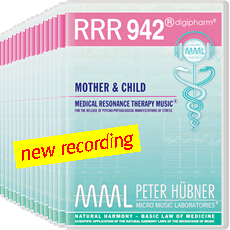| UNIVERSITY OF THE FUTURE |
| SCIENTIFICALLY INTRODUCING UNIVERSALITY TO THE UNIVERSITY |
|
| peter huebner • micro music laboratories |
| M E D I C A L R E S O N A N C E T H E R A P Y M U S I C® |
| R E D U C T I O N O F P S Y C H O – P H Y S I O L O G I C A L M A N I F E S T A T I O N S O F S T R E S S |
Scientific Studies and Clinical Observations
- Effects of the Medical Resonance Therapy Music® on hemodynamic parameters in children with autonomic nervous system disturbances: The treatments with the Medical Resonance Therapy Music® have a clear sympatholythic effect and lead the disturbed hemodynamic state of the child back to its healthy age norm. The greater effects of MRT-Music® treatments were seen in children with an initial absolute sympatheticotonia.
- Improved immune status in children with hearing abnormalities and suffering from radiation sickness: Two weeks after the treatment the immunogram of 25% of the patients was normal. Normalization regarded the AMG-factor, cellular immunity and the t- and b-lymphocytes. In the rest of the patients immune status improved clearly.
- Improvement in function of the infantile hearing organ in children suffering from radiation sickness: In 57% of the children with tubal disorder the negative pressure reduced by 15 mm – an indirect sign of a better functioning of the hearing organ. Audiograms and impedancometry documented a clear improvement in sound-transmission capability, which was subjectively confirmed by the children.
- Reduction of heart frequency in children with a tonisympathic form of vegetative angiodystonia: A positive effect took place already after the first treatment and had stabilized already after 3-4 treatments (2 days). The general state of health improved, heart beats per minutes reduced by 5 beats on average.
- Reduction of blood pressure in children with a tonisympathic form of vegetative angiodystonia: A positive effect took place already after the first treatment and had stabilized already after 3-4 treatments (2 days). The general state of health improved, breaths per minutes reduced by 1,9 breaths on average, systolic blood pressure reduced by 6.1 mm hg on average, diastolic blood pressure by 4.0 mm hg.
- Abstinence from tranquilizers for children with hearing disorders: The children liked the treatment with MRT-Music® very much, for them it was a great subjective and calming experience, especially for the age group 13-14 years. Due to MRT-Music® we did not need to use tranquilizers during the treatment for most of the children.
- Reducing irritability and improving composure in children with diabetes: 80% of the children experienced in this way a significant reduction of their irritability and showed greater composure.
- Improvement of the psychosomatic status of children suffering from radiation sickness: The evaluation of the Spielberger-Khanin scale documented in all children a clear release of stress; a great reduction in fear about the possibility of an unsuccessful outcome of the treatment of the illness; a decrease in worry and inhibitions and
a decrease in nervous reactions
If you want to look at the studies in detail, please visit:
